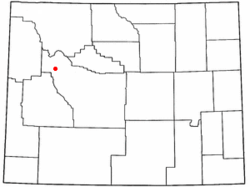Dubois, Wyoming
| Dubois, Wyoming | |
|---|---|
| Town | |

Along the main street in Dubois
|
|
| Motto: "Where Real Cowboys Work and Play" | |
 Location of Dubois, Wyoming |
|
| Location in the United States | |
| Coordinates: 43°32′9″N 109°38′9″W / 43.53583°N 109.63583°WCoordinates: 43°32′9″N 109°38′9″W / 43.53583°N 109.63583°W | |
| Country | United States |
| State | Wyoming |
| County | Fremont |
| Government | |
| • Mayor | Twila Blakeman |
| Area | |
| • Total | 3.43 sq mi (8.88 km2) |
| • Land | 3.42 sq mi (8.86 km2) |
| • Water | 0.01 sq mi (0.03 km2) |
| Elevation | 6,946 ft (2,117 m) |
| Population (2010) | |
| • Total | 971 |
| • Estimate (2012) | 1,002 |
| • Density | 283.9/sq mi (109.6/km2) |
| Time zone | Mountain (MST) (UTC-7) |
| • Summer (DST) | MDT (UTC-6) |
| ZIP code | 82513 |
| Area code(s) | 307 |
| FIPS code | 56-21415 |
| GNIS feature ID | 1609085 |
| Website | Dubois Wyoming |
Dubois /ˈdjuːbɔɪz/ DEW-boyz is a town in Fremont County, Wyoming. The population was 971 at the 2010 census, although it nearly doubles in the summer with many part-time residents.
The original residents of Dubois, Wyoming wanted to name the town "Tibo" after the name the local Shoshone tribe gave to the first missionary in the area. However, the postal service found the name unacceptable, so it endowed the town with the name Dubois after Fred Dubois, an Idaho senator at In protest, the citizens of Dubois rejected the French pronunciation, instead opting for Du, with u as in "Sue"; bois, with oi as in "voice". The accent is on the first syllable.
The first occupants of the mountains and valleys surrounding what is now Dubois were members of the Sheepeaters, a group of Mountain Shoshone, who included the Wind River area in their regular annual migrations from the Great Plains through the mountains of Yellowstone and beyond. The Wind River Valley surrounding Dubois contains numerous remnants of these people who lived in the area for many hundreds of years before they were relocated into a nearby reservation. Relics of their existence in the mountains and valleys around Dubois include numerous prehistoric petroglyphs, hunting traps and blinds, and stone tepee circles.
The first Europeans to enter the area were trappers Francois and Louis Verendrye in 1742–43. In the years to follow, the Wind River valley was visited regularly by the Astorians and other fur trappers and hunters through the early 19th century. The mountain man Jim Bridger, visited the area en route to Yellowstone in 1807 and 1808, named nearby Union Pass and Union Peak. The first homesteaders arrived in the late 1870s. [Jim Bridger was born March 17, 1804 near Richmond, Virginia... there is no way he could have explored this part of Fremont County in 1807 & 1808...]
...
Wikipedia

